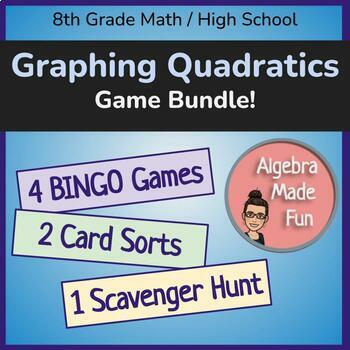Graphing Quadratic Functions Bundle
Algebra Made Fun
230 Followers
Algebra Made Fun
230 Followers
Products in this Bundle (7)
showing 1-5 of 7 products
Description
This is a bundle that will bring some energy to your Graphing Quadratic Functions unit! Included in the bundle:
- 2 matching activities that have students match up multiple representations of quadratic functions. There are options for using just one type of equation (vertex form, for example) or multiple forms (vertex, standard, and factored forms). One matching activity is meant as a quick partner activity, and the other is a group project where students make posters summarizing their learning.
- 4 BINGO games. All BINGO games use the same graphs, but the different games use different forms of the equations.
- Vertex form BINGO
- Factored form BINGO
- Standard form BINGO
- Combined forms BINGO
- Classroom Scavenger Hunt where students write the equation of a graph in vertex form, then convert it to standard form to find the next problem.
Total Pages
Answer Key
N/A
Teaching Duration
N/A
Last updated Nov 29th, 2022
Report this resource to TPT
Reported resources will be reviewed by our team. Report this resource to let us know if this resource violates TPT’s content guidelines.
Standards
to see state-specific standards (only available in the US).
CCSS8.F.A.2
Compare properties of two functions each represented in a different way (algebraically, graphically, numerically in tables, or by verbal descriptions). For example, given a linear function represented by a table of values and a linear function represented by an algebraic expression, determine which function has the greater rate of change.
CCSSHSF-IF.A.2
Use function notation, evaluate functions for inputs in their domains, and interpret statements that use function notation in terms of a context.
CCSSHSF-IF.B.4
For a function that models a relationship between two quantities, interpret key features of graphs and tables in terms of the quantities, and sketch graphs showing key features given a verbal description of the relationship.
CCSSHSF-IF.C.7
Graph functions expressed symbolically and show key features of the graph, by hand in simple cases and using technology for more complicated cases.
CCSSHSF-IF.C.7a
Graph linear and quadratic functions and show intercepts, maxima, and minima.





